Air
Hawk
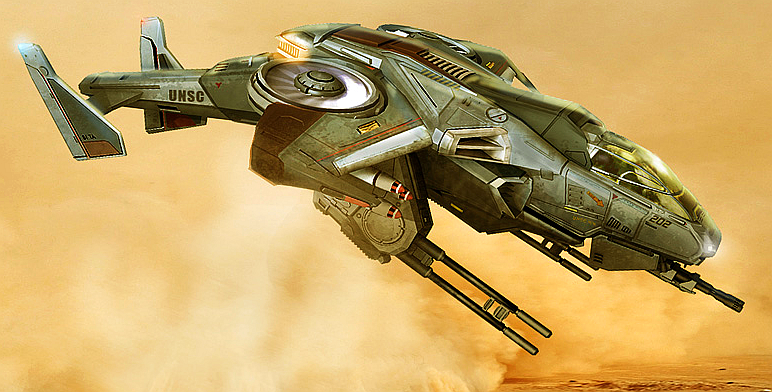
The Hawk is a formidable air-to-ground anti-tank aerodyne It is used by the Armintagian military in a support and anti-armor role to hunt tanks and support advances. The Hawk has design elements from a mixture of modern VTOL aircraft, most prominently the Harrier Jump-Jet, and attack helicopter gunships such as the AH-64 Apache and the AH-1 Cobra. It consists of an elongated fuselage with stubby wings on each side of it. The cockpit is forward mounted, and the tail section juts out from behind the fuselage at a downward angle. Each wing incorporates a ducted air fan for lift and thrust, and carries three missiles/rockets on pylons on each wing. Each wing also carries a twin auto-cannon, with a dual auto-cannon mounted underneath the cockpit. The Hawk is a fast and maneuverable aircraft, much more so than the AV-14 Attack VTOL that it replaces. It uses ducted fans in the wings for propulsion rather than tilting jet thrusters, and is equipped with wing-mounted GUA-23/AW/Linkless Feed Autocannons and a nose-mounted M6 laser which takes up the length of the entire aircraft excluding the tailpiece, excelling at anti-vehicle operations but more than capable of engaging most types of units easily.
D77H-TCI Pelican Dropship
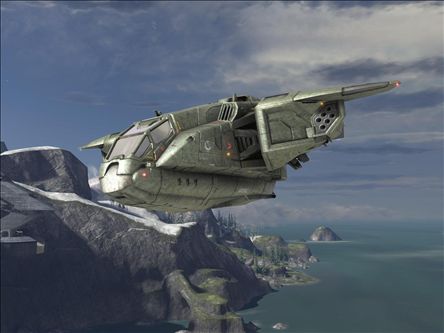
Though an upgrade, the D77H-TCI variant of the Pelican carries the same number of passengers as its predecessor, 10 seated and 15 standing. However, it has an Hermetic Door on its Rear Section for Atmosphere insertions. The D77H-TCI Pelican's cockpit also differs from its predecessor, using a tandem seating rather than the side-by-side configuration used on the D77-TC. It is presumed that the pilot furthest toward the front operates the craft's flight systems, with the co-pilot seated behind him operating the other systems. A small holo-tank has been installed in the series, allowing an artificial intelligence to project its holographic form to the craft's pilots. Its tail mounted magnetic clamps are capable of carrying any single land vehicle in the Armintagian Military. The D77H-TCI Pelican lacks a nose-mounted chain-gun, though it is able to mount an AIE-486H Heavy Machine Gun in its troop-bay compartment for supporting ground teams and covering the ingress/egress of its passengers, an improvement from the previous M247 GPMG. Its wings can attach on 2 missile-pods for engaging air or ground hostile units, which has proven effective against enemy dropships and infantry, able to fire more missiles and faster than the older ANVIL-II ASM Pods. It can fire up to 12 missiles at once, 6 from each pod. The D77H-TCI can also be equipped with a much larger cannon, mounted at the ventral-fore of the dropship other than this, the D77H-TCI carries relatively few weapons. The main engines are mounted in pairs in four nacelles, one situated on each wing and two at the rear and posterior. The nacelles can articulate independently, thus altering (referred to as vectoring in aviation) the direction of thrust and improving the D77H-TCI Pelican's low speed and low altitude maneuverability. Four ventral thrusters are identified by markings and a rendered thrust effect, one on each wing nacelle and one on each aft nacelle, allow the drop ship to land and take off vertically. These engines are capable of both space and atmospheric operation. It has 8 jet intakes, 3 on each side and 2 on top. The D77H-TCI Pelican is too small to have a Slipspace matrix mounted inside. The wings mounted on a Pelican seem extremely small, too small to support the weight of drop ship and payload alone. It is speculated that it utilizes at least some Lifting Body principles, using its own hull create most of the lift necessary for flight. Although it is more likely that the Pelican partially relies upon thrust vectoring, referred to as jet-borne flight as opposed to wing-borne flight which can be further reinforced with the fact that down-ward aiming jets can be seen on the bottom of the thruster mountings. It should be noted that small wings are very efficient for high-speed flight. It is also a benefit for operations in the upper atmosphere, especially re-entry.
Vulture
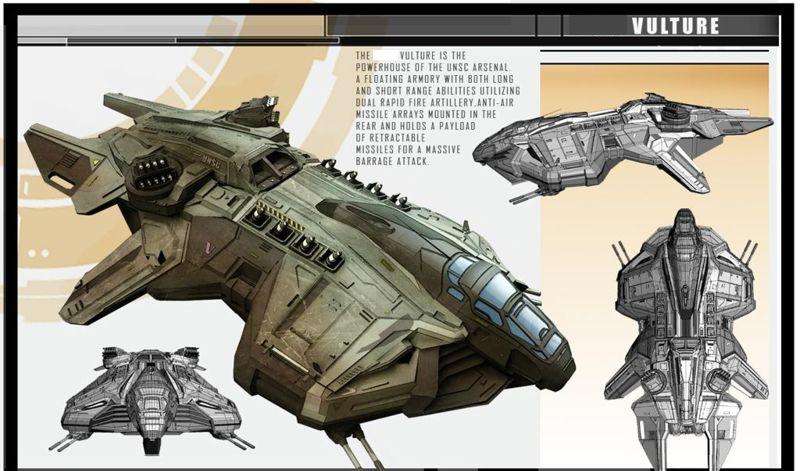
A slow unit which can take massive amounts of damage before destruction, the Vulture is the largest ground-based aircraft. It is able to fight against both air and ground units due to its weapon configuration (Argent V MissilePods for aircraft, GUA Autocannons for ground units). Thanks to its "Barrage" ability, it can deliver massive damage to slow and/or static units. The Vulture main drawbacks are its cost and the large amount of time it takes to build one; it is also vunerable to fast counterattacks and very hard to repair. It is suspended by a series of ducted fans visible near the rear of the aircraft, or jet engines. Two ducts underneath the vulture barely visible make it able to hover. It is slower than other aircraft, such as the Hawk, but is armed with a number of devastating missile artillery pods for engaging enemy ground and air units, able to fire off huge barrages of missiles, as well as a pair of humm-mounted autocannons. It has a Mega Barrage, potentially doubling its barrage power, which allows double the amount of its destructive missiles to be launched in one strike.
Land
M808B Main Battle Tank

The sturdy M808B Scorpion MBT is an armored tracked vehicle used during planetary combat. It can seat a driver, a gunner and four passengers that sit two on each side. It lacks speed but the main cannon has a higher rate of fire, allowing for more damage to be dealt out, and has much greater accuracy, with no need to compensate for anything but muzzle-to-target travel time. Its main function is to provide anti-vehicular support. The Scorpion is equipped with two weapon systems. It has a short-to-medium-range coaxial machine gun and an extremely powerful main cannon. While the main cannon can only shoot one round every three to four seconds, the machine gun has unlimited ammunition and can fire even when the cannon is reloading. The Scorpion's chassis is covered with heavy titanium-ceramic armor plating, making it mostly immune to small-arms fire; however, it's still possible for anti-tank infantry weapons to inflict severe damage on the vehicle, even destroying it. The Scorpion has a dead space around it because the turret is mounted far back and elevated. The tank houses an interesting track assembly, made of four bogeys, or tread assemblies, with two on each flank of the vehicle, front-to-back. This makes the Scorpion a rather broad target and presumably easy to spot from the air; on the other hand it does give the tank better traction on rough ground. Although it has been stated numerous times to be a main battle tank, it seems to have been designed as a lighter armored vehicle. The Scorpion only has two visible internal crew compartments, and in later models a small area where a crew member can man a machine gun for anti-infantry defensive capabilities. There may be another crew member in the turret serving as a loader/gunner, but it is more likely that the Scorpion uses an autoloader, giving it a probable maximum of three crew members and room for additional passengers on the outside. It may be that advances in tank technology have allowed for smaller crews in MBT's. Any marines sitting on the tread covers of the Scorpion will be vulnerable to small-arms fire, and any explosions that occur near the tank may kill all the crew sitting on the tread covers, while leaving crew members relatively unscathed. Its cannon, a 90mm piece, also appears weak when compared to modern MBT armaments: the M1A2 Abrams tank, for example, mounts a 120mm cannon. Alternatively, the 90mm cannon could be the "light" variant of the M808, while a 105mm cannon can be mounted for greater offensive power.
Grizzly
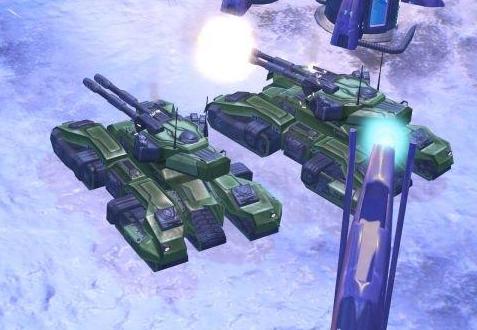
The Grizzly is an upgrade to the M808B Main Battle Tank. It is out fitted with twin cannons, a heavy machine gun, and a shrapnel based rocket launcher as its secondary ability. The Grizzly is an extremely capable unit, suitable for defeating large amounts of enemy armor and infantry. Since it posesses a secondary canister shell attack, it can decimate infantry squads with ease due to large area damage. Its main disadvantages are its turret's slow turning rate and its cost. The armor plating has also been improved. The co-axial machine gun has a faster firing rate and inflicts more damage per hit than the Scorpion, at the cost of taking a little longer to reload.
MAAT-9 Wolverine

As the name suggests, the Main Anti-Air Tank Wolverine is designed for anti-air combat. In its arsenal are two pods of Argent V Missiles that are located on the left and right of the driver and gunner seats. These missiles are specialized to target and deliver their warhead to an aircraft with great speed and maneuverability. The missile pods are quite large and can be reloaded via a mechanical system in the Wolverine, which stores a small supply of missiles onboard, the exact standard amount is unknown. The laser tracking targeting systems and anti-air capabilities of the Wolverine are second to none, but it can also angle its missile pods to launch missiles at ground targets, preferably stationary targets or structures. Although air vehicles generally know to steer clear, the Wolverine is quite vulnerable to anti-armor attacks both from vehicles or heavily upgraded infantry, possessing only light armor. However, it is a versatile unit for rough terrain operations. The driver has the use of a pivoting XM511 Heavy Grenade Launcher for defense from ground attacks, which can potentially wreck soft targets, but truly this support vehicle relies on heavier units to defend it from a determined attack.
SP42 Cobra
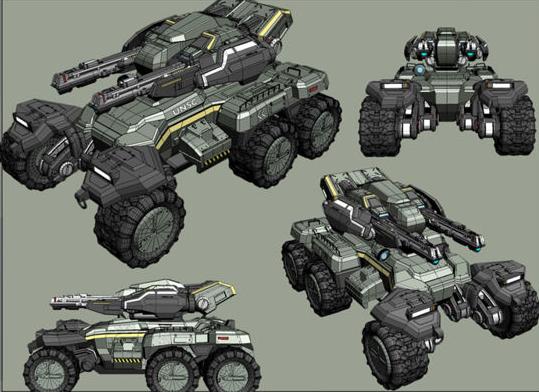
Unlike many vehicles, the Cobra fills two distinct roles, that of a mobile Anti-Vehicle platform, and of a self-propelled artillery piece. It features armored panels that are designed to deflect hardened projectiles and absorb massive amounts of damage from explosive shells. Although it is not fast, the Cobra is still highly maneuverable, and can keep up with combat groups. The SP42 Cobra is equipped with a pair of M66 Guass Cannons on its turret that fire a high-density ferrous slug designed to penetrate enemy armor using sheer kinetic energy. It has a slow rate of fire, although it also fires a projectile twice the size of a M68 Gauss Cannon slug. The M66s fire intermittently, not in a single burst, as the energy required to accelerate the slug to the speeds required to pierce the heaviest armor can only be managed for one of the cannons at a time. Synchronized fire from both Gauss Cannons will destroy even the most heavily armored tank, with penetration that easily out-guns the standard 90mm gun of the M808B Scorpion MBT. In addition to the Cobra's anti-vehicle role, the Marine tank crews can stabilize the vehicle into the ground, "locking it down", and deploy an Arcing trajectory cannon which fires a conventional explosive shell at supersonic velocities, with both the explosive and kinetic force adding to the damage inflicted. It sacrifices mobility for the range that elevating the heavy weapon can offer. The shells used are multipurpose, and can be adapted to eliminate anything from a formation of enemy tanks to an enemy fortification or firebase, though its use against groups of infantry may be less effective if they are spread apart due to its small blast radius.
Warthog

The Warthog is the future HMMWV. All of its variants are equipped with a seemingly full-time 4x4 transmission and four-wheel steering to allow for sharper turning; however, higher speeds will result in the under steer that All Wheel Drive (AWD) cars suffer, unless you drive while using the emergency brake. Most Warthog variants support a three man crew consisting of: 1 driver, 1 gunner, and 1 armed passenger. The Warthog LRV is water-resistant; it can easily ford water, although water retards its velocity. The Warthog is extremely quick and maneuverable, but is prone to rollover as a result of tight cornering or being struck by explosives or heavy weapons fire. The M12 Warthog LRV (Light Reconnaissance Vehicle) is the most common and versatile type of Warthog. While nominally designed for reconnaissance, its speed and firepower make it very effective in a cavalry role. The rear-mounted, three-barreled M41 Light Anti-Aircraft Gun 12.7 mm, is extremely effective against infantry and light vehicles, and is capable of picking apart armor should the need arise.